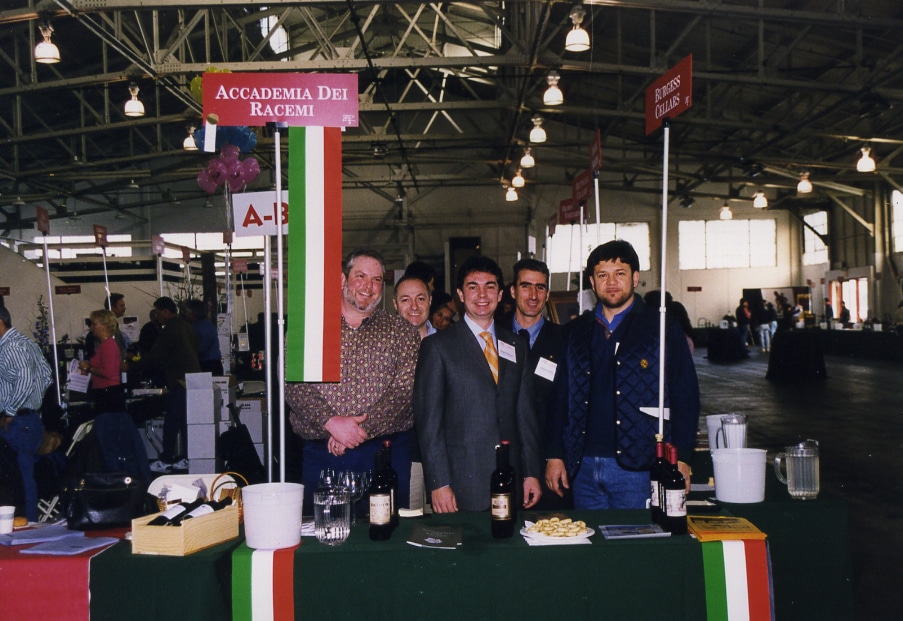It all began with Gregorio Perrucci, the eldest son of a day laborers family. He was an expert “INNESTINO ”, in the service of numerous noble Mandurian landowners, who returned unharmed from the Second World War. Back then there was a desire to rebuild Italy, but also to change it.
The Agrarian Reform forces landowners to cede a large part of their lands to farmers, who begin to reclaim these, plant vineyards and produce their own wine using collective structures called “palmenti”.
Gregorio is everyone’s point of reference to graft new Primitivo plants. Together with his brothers, he also starts a brokerage business to sell in bulk the wine produced by Mandurian families.
Gregorio, having grafted most of the new vineyards at that time, knows the various Primitivo qualities in relation to the different types of soil: red soil, sand, black and white soil.
Costantino Perrucci, Gregorio’s eldest son, continued the brokerage activity according to the teachings of his mentor, uncle Florenzo.
We are in the early 60s, Italy’s redemption from poverty has now begun and the consumption of “Manduria” or “Sava” in northern Italy is widespread, especially thanks to the emigrated families from the south who set up bulk sales there.
Costantino and his brothers decide to open a real winery. The ancient “palmenti” were giving way to the modern wine cooperatives, where, however, grapes were brought collectively, sacrificing the individuality of different vineyards.
In 1973 the MEC (Common European Market) was established and customs barriers in Europe began to be eliminated. Great opportunities open up for producers from the south: Sicily first and Puglia immediately after.
Costantino Perrucci builds the third winery, well designed to process large quantities of grapes and logistically capable of supplying entire tankers that weekly sailed from the nearby ports of Gallipoli, Taranto and Brindisi.
By the mid 90s, he had become one of the major Italian exporters of bulk wine, with an average sales volume of around 100 million liters per year.
Gregory Perrucci, Costantino’s eldest son, who joined the company in 1989 to carry on the family business, initiates a “return” to viticulture. Together with his brothers he began to set up a “corner” for quality winemaking in his father’s large company and a new bottling winery in 1992.
Gregory dedicates himself to Primitivo, to the purchase of interesting vineyards and to modern winemaking techniques, many of which learned during his numerous trips to California. Trips in which he also investigates the link between Primitivo and Californian Zinfandel and, above all, the reasons behind the latter’s success, despite the completely “anonymous” diffusion of the former.
In order to strengthen the agricultural dimension of his production, he relies on Salvatore Mero, a son of art of the ancient wine making wisdom of the Primitivo.
At the beginning of the 90s, the team gathered important collaborations: the arrival of the oenologist Roberto Cipresso, who had gained experience in important companies in Montalcino, caused a stir.
Felline begins to operate on the market in 1996 presenting itself with completely new, modern and clean Primitivi di Manduria; blends never risked till then, such as the Alberello: Primitivo and Negramaro; or the Vigna del Feudo: Primitivo, Montepulciano and Cabernet Sauvignon.

Felline Soc. Agricola a.r.l.
S.Comunale Santo Stasi I, 42
74024 Manduria (Ta) Italia
P.I. – C.F. 02939250730
Copyright 2023 – Privacy and Cookie Policy – Comunic@ndo





Attraverso la collaborazione con viticultori di territori diversi della regione ed enologi con esperienze nelle vinificazioni di qualità, vengono “offerti” alla conoscenza di giornalisti e importatori le nuove produzioni da uve fino ad allora del tutto trascurate o sconosciute:
Ottavianello, Susumaniello (recuperato da Gregory con l’azienda Torre Guaceto), Fiano Minutolo (azienda Sammartino), oltre a nuove versioni di Negroamaro e Malvasia Nera (azienda Castel di Salve), Moscato Reale di Trani (azienda De Filippo), uva di Troia e Montepulciano (azienda Paolo Petrilli) e ovviamente la zonazione di Primitivo (terra rossa, bianca, nera e sabbia).
L’Accademia dei Racemi annovera tra le consulenze, oltre a Roberto Cipresso e Fabrizio Perrucci, Enzo Moiso, Luca Boaretti. Tuttora alcune aziende create dall’Accademia dei Racemi sono presenti con onore sul mercato.
Oltre a far parlare di sé per i propri vini, l’Accademia dei Racemi diventa un riferimento unico nel panorama regionale per la ricerca, lo studio, la sperimentazione dei vitigni autoctoni.
Per gli esami condotti sulle relazioni tra Primitivo e Zinfandel, la storia e le sperimentazioni, nonché la richiesta di aggiornamento dell’elenco dei sinonimi regolamentato dalla Unione Europea, Gregory Perrucci viene ammesso come unico “membro non americano” nella prestigiosa associazione californiana denominata Zap (Zinfandel Advocates and Producers).
Alcuni anni dopo, precisamente nel giugno 2002 dopo la decretazione scientifica dell’identità tra Zinfandel e Primitivo, nonché tra essi e il croato Crnjelak Kastelansky, è relatore al primo Convegno Internazionale sullo Zinfandel. Tiene una relazione sulle origini del primitivo e i suoi rapporti con lo Zagarese (scomparso) in una sessione congiunta con Doug Beckett (enologo californiano) e il mitico Miljenko Grgich, icona dell’enologia americana per avere prodotto due dei vini che nel concorso mondiale di Parigi del 1976 alla cieca sbaragliarono i vini francesi.